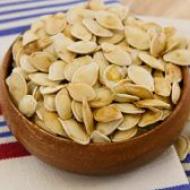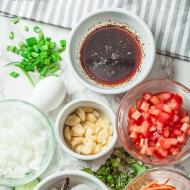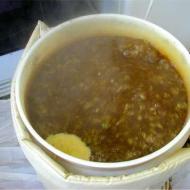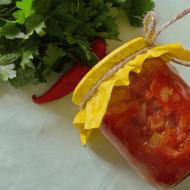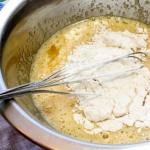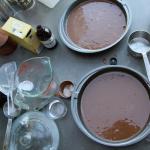
How to brew hop yeast. Homemade yeast at home
You can prepare your own at home, homemade yeast . This is the most authentic natural yeast, given to us by nature itself. Our task is only to activate them - and propagate them at home for our needs.
Yeast from hops
You will need hop cones - dry or fresh - it doesn’t matter.
Place the hop cones in a saucepan and fill with hot water. Boil for 1 hour.
Strain the cooled broth.
Add sugar and flour (twice as much flour as sugar). Mix and place in a warm place for 1.5 days.
Add grated boiled potatoes to the mixture (add potatoes until the porridge becomes thick), mix and set to ripen for a day.
My grandmother once made yeast from hops, the ripening process took place in a large clay pot, the bread turned out to be especially tasty, and she baked it in a Russian oven. And in my opinion, my grandmother did not add potatoes, but she no longer remembers how exactly she did it, because... She is now 94 years old. That’s why you have to use this version of the recipe.
Yeast from sprouted wheat grains
Wet a glass of wheat and leave it for a day and a half to germinate.
Grind until mushy.
Add 1-2 table. spoons of sugar
Then add flour and bring to a thick porridge. Mix well and cook over low heat for 20 minutes.
Place in a warm place - as soon as bubbles appear, the yeast starter is ready. (In about a day).
How to use homemade yeast? It’s difficult to tell the exact proportions - it all depends on how successful your activation process was and under what conditions the yeast ripened. Exactly how much yeast to add to the dough in your case can only be determined experimentally. Because everyone’s homemade yeast is different in “strength”.
If you prepare homemade yeast in some other way, share your recipe in the comments!
(Visited 3,074 times, 1 visits today)
Before we start looking at recipes for making yeast from hops at home, let’s talk a little about the history and biology of the issue.
Many scientists believe that yeast is the first living creature domesticated by humans. Modern excavations prove that the ancient Egyptians used them for fermentation or baking as early as six thousand years BC. When buying yeast in a store in the form of sticks or dry powder, many do not even suspect that these are living organisms. More precisely, mushrooms that have lost the ability to form mycelium and have adapted to live in liquid substrates.
As for the use of hops in the preparation of yeast, this is also quite an ancient story. People have long noticed the properties of this plant and began to use it in various products using fermentation. It is not for nothing that in Russian “intoxicated” is a synonym for the word “drunk”.
Harvesting and storage of hops
In order to be able to prepare yeast from hops all year round, it must be properly prepared and stored. It should be noted that cones, which are bracts, are collected from hops. It is in them that valuable pollen called “lupulin” is formed, which, in addition to the formation of yeast, also gives the products a unique beer taste.
Hops picking
Depending on the region, hops bloom during different months of the summer, but the best time to harvest hop cones is when the bloom is coming to an end. At this moment, the largest amount of lupulin accumulates in them.
Advice! To determine the ripeness of the cones, they are rubbed between the palms. If a greenish-yellow resin appears on them, the hops are ready for harvesting.
The hop plant is a long vine, sometimes growing up to five meters in length. Experienced gardeners cultivating this plant do it very simply. During the harvesting season, the shoots are cut off almost at the root, and then the cones are picked off from them quietly on the ground. There is nothing to be sad about the fate of the plant. Next year, new bushes will grow from the roots.
Drying
After the cones are collected, they need to be dried quickly. To do this, the cones are laid out under a canopy in trays or on burlap; you can also use old paper. The bud layer should be kept to a minimum to prevent premature fermentation of the lupulin.
If the weather outside is rainy and damp, then drying is best done in closed attics or glazed verandas. Properly dried raw materials practically do not lose their green color, only becoming slightly dull.
Storage
Properly dried hops can be stored for up to three years. To do this, it is poured into canvas bags, which are kept in a cool, dry room.
During storage, hops need to be inspected periodically. The appearance of black spots on the cones indicates that the raw material has been damaged; in this case, it cannot be used for making yeast or beer.
Acquisition
Nowadays, buying hops is also not a problem. It is mainly purchased for brewing, but it can also be used for making yeast. Already processed granulated hops are placed in bags, which are more convenient to store, package and transport.
Yeast recipes
If you have prepared hops yourself or purchased them at a retail outlet, then it’s time to get acquainted with how to make yeast from hops. There are several options for preparing them, using different ingredients.
From fresh hops
Homemade hop yeast is the most aromatic when you use freshly harvested hop cones. To prepare them, you need to take the following amount of ingredients for one liter of pine cone decoction:
- salt – ½ tablespoon;
- granulated sugar – 100 grams;
- wheat flour – 1 cup;
- potatoes – 1-2 pieces.
The cooking process is simple, but requires strict adherence to technology.
- First you need to pour hop cones into a pan and pour hot water over them.
- Boil hops in slightly boiling water for an hour.
- Strain the broth and measure its volume.
Attention! The amount of ingredients is calculated exactly for the volume of the decoction.
- Add salt, sugar and flour. Mix everything thoroughly.
- Place the dishes in a warm place for two days.
- After this time, add boiled mashed potatoes to the mixture. The amount of mashed potatoes should be such as to bring the broth to the consistency of sour cream.
- In a day the yeast will be ready. All that remains is to pour them into jars or bottles.
Store hop yeast in the refrigerator to reduce its activity.
From dry hops
Sourdough from dried or pre-processed hops at the factory is made without using potatoes, and the recipe is slightly modified. We will indicate the quantity of ingredients directly in the text:
- Pour one part of the dry hops into the pan.
- Fill with two parts water.
- Boil until the liquid reduces by half.
- Strain the broth.
- Add a tablespoon of sugar for each glass of broth.
- Then you need to add wheat flour with constant stirring at the rate of half a glass per glass of liquid.
- Remove the pan to a warm place.
The yeast will be ready in 30-40 hours. You can feel this moment by the characteristic yeasty smell of sourdough.
Yeast from a thermos
Instead of boiling the cones, you can use the method of steaming them in a thermos. To make such a leaven for bread from hops you need to take the following amount of products:
- fresh water – 1 glass;
- dry or fresh hops – 2 tablespoons;
- sugar – 1 tablespoon;
- salt – ½ teaspoon;
- first grade wheat flour – 110 grams;
- boiled potatoes – 100 grams.
When preparing yeast according to this recipe, the method of steaming buds is used, so:
- Place hop cones in a thermos.
- Pour boiling water over them.
- We wait for the water to cool completely; in a good thermos this process lasts a day.
- Strain the broth through a sieve.
- Add salt, flour and sugar - mix everything thoroughly and put it in a warm place.
- Keep the mixture in a warm place for two days, during which time we stir it several times.
- Boil the potatoes and make mashed potatoes.
- Add the puree to the almost ready yeast and keep it for another day.
You should get almost half a liter of yeast. In the recipe from Elena Molokhovets, it is recommended to take a full spoonful of the resulting yeast per pound of flour.
Reference! One pound is equal to approximately 400 grams.
Kvass from hops
As mentioned above, hops are used for more than just yeast. Its main purpose is to prepare beer. We want to treat our readers to a recipe on how to make kvass from hops at home.
Product composition:
- water – 3 liters;
- yeast – 10 grams;
- hops – 30 grams;
- wheat flour – 10 grams;
- rye crackers – 300 grams;
- granulated sugar – 50 grams;
- raisins – 25 grams.
The procedure for preparing kvass is as follows:
- We make yeast starter: dissolve yeast, a little sugar, sugar and flour in half a glass of warm water.
- Place rye crackers in a three-liter jar.
- Fill the jar with boiling water up to the shoulders.
- Add the remaining granulated sugar, raisins and hop cones.
- After cooling to room temperature, add the yeast starter.
- Mix everything, cover the jar with gauze and leave to ferment for two days.
The finished kvass must be drained from the sediment, add 3 tablespoons of sugar to the remaining starter and add warm water. In this way, a continuous process of preparing kvass is organized. You just need to control the amount of starter and add crackers for color and flavor.
An interesting video on this topic will help us summarize the conversation about preparing yeast from hops at home.
Since the time when humanity learned to process grain into flour, bread and bakery products have become one of the most popular and vital food products, occupying a special place in the daily diet of the majority of the Earth's inhabitants.
In this article we will look at how to make your own from ingredients such as hops and yeast. A recipe for making bread with hop sourdough will also be presented to your attention.
- yeast or yeast-free?
In recent years, one can often hear discussions about which bread is the healthiest. Proponents of baking without baker's yeast are convinced that they gradually accumulate and multiply in the human body, destroying the beneficial microflora of the intestines and stomach, undermine the immune system, cause tumor processes and much more. Therefore, fans of healthy eating suggest giving up yeast bread and baking yeast-free baked goods, for the preparation of which they use homemade starters. They are quite simple and easy to prepare. To do this, you will need the most common and familiar products for everyone, which are available in almost every kitchen.
How was yeast made in Rus'?
In the old days, bread was always baked using sourdough. All components were exclusively of plant origin. Such yeast was prepared from hops, wheat, barley, rye flour, oats, straw with the addition of raisins, sugar or honey, and malt. Today, in many remote villages, many cooking recipes are still preserved. It was these starters that enriched the human body with vitamins, organic acids, enzymes, fiber, minerals, biostimulants, pectin substances, saturated it with oxygen, etc.
Over time, bread baking technology has changed, but the raw materials have remained almost always the same. From century to century they used water, flour, salt and leaven or yeast. But if yeast was used only as needed, leaven was constantly present. With the growth of the population and consumer needs for bread, “capricious” yeast from hops began to be used less and less.

Sourdough bread made from hops
Yeast-free homemade bread made with hop sourdough is considered by many to be very healthy. It is best to use wild hops for baking, which are collected in the summer, in the last ten days of August or in early September, during the period of technical ripeness, and dried in the shade. However, a pharmacy one might do.
Today there are many recipes and tips on how to make yeast from hops at home. The main ingredients of such starter cultures are flour, a decoction of hop cones and sugar (you can use honey). Sometimes boiled potatoes are added.
Yeast from hops at home: benefits and harms
Those who believe that yeast is only a guarantee of fluffy baked goods and a “provocateur” of excess weight are mistaken. In fact, they are a real storehouse of necessary and useful substances. Homemade hop yeast is rich in vitamins, minerals and trace elements. They contain:
- valuable protein that is easily digested and absorbed;
- carbohydrates (up to 30% of the total composition of the starter);
- vitamins of group B1, B2, B5, B6, PP and D;
- minerals: calcium, iron, magnesium, zinc and manganese.
As for calorie content, 100 g of homemade yeast contains 50-70 calories, which is not so much for a slim figure.
Bread with hop sourdough has a positive effect on the entire human body, is better absorbed and greatly facilitates the digestion process. This is due to its density and roughness: in a food bolus, a dense crumb helps improve intestinal function, due to which the work of the muscles of the digestive system is activated, food is better absorbed, and there are benefits for the intestines - it trains and becomes healthier. Besides:
- bread that uses hop yeast is more resistant to potato disease;
- it contains fewer foreign microorganisms that do not participate in fermentation;
- Hop bread has a pleasant aroma and good taste;
- such bakery products are better stored;
- Yeast from hops contains medicinal components.
So hop bread is an excellent product of yeast fermentation, healthy, tasty and good quality.

Harm
Bread, for the preparation of which yeast from hops is used, is a product for everyone, since not every person accustomed to the taste of a loaf will like baked goods with a sour taste and the addition of bran and herbs. In addition, yeast-free bread has a denser and harder consistency, so it is smaller in volume than yeast bread, which has the same weight and a softer crumb. Another disadvantage is the difficulty of preparation. Baking bread with hop yeast requires a little more time and effort than preparing regular bread, since sourdough dough takes longer to rise, and the sourdough itself must be prepared. With ordinary baker's yeast it is much easier: add powder, wait until the dough rises, and bake.

How to make yeast from hops?
Yeast prepared at home is almost in no way inferior to its factory-made counterparts. Since they are prepared by hand, the risk of the dough not rising due to the low quality of the components is completely eliminated. Store-bought products are often stale or frozen, which always has a negative impact on baked goods.
So, in order to get homemade yeast, you need:
- First of all, learn how to make yeast from hops, study the preparation process in detail.
- Then purchase the necessary products.
- Know exactly where they will be used.
How to properly collect hops for making yeast?
Only those hop cones that are in a state of technical ripeness are suitable for harvesting. This can be determined by several signs:
- The hop cones become closed and seemingly smooth.
- Their color becomes lighter, such as golden green or yellowish green.
- To the touch, the cones become denser, stickier, and the scales fit tightly to each other.
- If you squeeze them slightly, they should be elastic, rustle, spring back and easily restore their original shape.
You cannot be late in harvesting hops. The cones very quickly become brown and their properties deteriorate. However, you shouldn’t rush to collect either. Harvesting begins selectively, with the most ripe cones, tearing off each of them separately. Hops are not collected in branches or clusters. To preserve the integrity of the cones, they are torn off along with the petioles, whose length must be at least 2 cm. The harvested crop cannot be crushed, tamped or compacted, as this deteriorates their quality. After collection, you should immediately begin drying, since the collected raw materials begin to deteriorate quickly.

Recipes for making yeast from hops
There are many recipes for baking homemade bread with hops, and they differ not only in the type of flour (rye, wheat, etc.) or their combination, fillers (bran, malt, seasonings, etc.), but also directly in the type of sourdough itself. As a rule, it can be liquid or dry, and also in the form of a piece of leftover ready-made dough.
Before preparing yeast from hops at home, carefully read the recipes, recommendations of people who share their personal experiences, and choose the most suitable option for yourself.
Recipe No. 1
The standard recipe is a liquid hop starter, which is prepared from hop cones. In the evening, ripened and thoroughly dried cones are poured with boiling water in a ratio of 1:2 (for example, 1 cup of cones and 2 cups of hot water), boiled for 20 minutes, wrapped in a towel and left overnight. In the morning, filter through cheesecloth. Sugar (or honey) and flour are added to the decoction in the following ratio: for each glass of hop decoction - half a glass of flour and 2 tbsp. spoons of sugar. The resulting mixture is well wrapped and placed in a warm place for fermentation for two to three days. Every day it is heated in a water bath, while stirring continuously. If this is not done, the fermentation process may stop. Ready yeast has many bubbles and a characteristically bitter taste. The starter is stored in the refrigerator, in bottles or jars with hermetically sealed lids.
The dough consumption is as follows: 1 cup of ready-made liquid yeast per 2 or 3 kg of flour, plus wheat flour for mixing. If baking is added to the dough (for example, when baking paska), it is advisable to add 0.3-0.5 cups of sourdough to improve the convergence of the dough.
Recipe No. 2
Let's look at how to make yeast from hops and bran. Instead of flour, bran is added to the strained decoction made from hop cones. The mass is mixed well, then placed in a warm place for 3 days and stirred periodically. from hops and bran are ready if a characteristic, sour and not very pleasant smell appears. Fermented bran is scattered in a thin layer on a table or baking sheet to dry. The dried hop starter is placed in a hermetically sealed container. In this form, it is suitable for long-term storage, without refrigeration. Before using it, pour it with warm water overnight at the rate of 1 teaspoon per half glass of water, add a little flour, stir until the sour cream becomes thick. In the morning, water, salt and flour are added to the foamed mass and the dough is kneaded.
Recipe No. 3
A finished hop starter is a small piece of dough that was previously prepared using a hop starter. Usually it is left after the bread is prepared, placed in a sealable container or bag and sent to the refrigerator. Moreover, the lump can even be very small, approximately 1 cm3. Before use, the starter is placed in a container for preparing dough, poured with a small amount of warm water, stirred well, a little flour is added and placed in a warm place. Every 1.5-2 hours add water and flour and adjust to the required volume. Bread prepared with this sourdough tastes a little more sour than with fresh liquid hop sourdough, and rises a little longer.
It is better to prepare rye sourdough with sourdough No. 3, and baked goods and white sourdough with fresh liquid sourdough according to recipe No. 1 and No. 2, since the taste and convergence of the dough are better.
There are many other recipes, for example, how to make homemade yeast from hops and raisins, etc.
And one more important point - in order for the bread to rise better, place the dough in greased molds no more than half their volume, cover with a towel and leave for 1.5-2 hours. Bake bread at 200 degrees C for 50-60 minutes. The finished product is taken out of the mold, sprinkled with water and wrapped in a towel to make it soft and fragrant.

from hops
Homemade kvass, thanks to its special composition, perfectly quenches thirst, gives the body energy, and increases performance. In addition, this wonderful drink increases performance, restores the balance of fluids and salts in the body, and improves the digestion process.
Making yeast from hops for kvass is very simple and easy. You can collect hop cones yourself or purchase them at any pharmacy.
Required ingredients:
- half a liter of water;
- 3 tablespoons hops;
- 1 tablespoon of sugar or honey;
- flour.
Preparation of yeast from hops for kvass:
Pour 3 tbsp. spoons of hops and half a liter of boiling water. Place the pan over low heat and simmer for approximately 15 minutes. Then strain the hop decoction and cool to 38-40 degrees. Add 1 tbsp. a spoonful of sugar (optional) honey, mix well. Add flour until you get a mass of sour cream consistency. Cover the container with a napkin and leave for 1-1.5 days. The finished starter can be stored in the refrigerator.

How to make moonshine
Making moonshine with your own hands is a rather difficult process, requiring close attention and constant monitoring of temperature and time conditions. There are many different recipes for its preparation, but we will look at how to make moonshine using hops.
Preparation of raw materials for mash
First of all, you need to prepare yeast from hops for moonshine.
To do this, take a pan (preferably enameled), fill it to the very top with freshly picked hop cones, fill it with warm water, then cover it with a lid and cook for 1 hour. Next, filter the resulting broth through cheesecloth (about 2 liters), add 250 g of sugar (a full glass) and 2 cups of flour. The resulting mass is mixed well and then placed in a warm place for 1.5 days. Take 2 potatoes, grind them and add them to the starter. Mix thoroughly again and return to a warm place for a day. The prepared yeast is poured into bottles, tightly closed and kept in the cold.
If you don’t have fresh hops on hand, then you can take dried ones and fill them with water (1 part hops and 2 parts water). Bring the mixture to a boil. After reducing the amount of water by half, remove from heat, strain and add sugar (put 1 tablespoon per 1 glass of broth). After the sugar has dissolved, carefully add wheat flour (0.5 cup is needed for 1 cup of syrup). Cover the container with the composition with a cotton cloth and place it in a warm place.
Now you need to prepare the mash itself. For the production of high-quality moonshine, a desirable component is sprouted grain (malt). It is endowed with high enzymatic activity. Take coarsely ground dried malt and add water at the rate of 1 to 3. Also, per 1 kg of grain add 200 g of sugar and 50 g of hop yeast (how to make homemade yeast from hops is described above). Cover the container with the mash with a clean cloth and leave for about two weeks in a warm place until the end of fermentation. The contents must be stirred periodically and any foam that has formed must be removed.
Fermentation process
This is the main stage of making moonshine. At the beginning of the process, there is an intensive release of carbon dioxide, the sugar concentration decreases, and the temperature of the mash itself increases by 2-3 degrees. The duration of this process is about 30 hours.
Then a large number of bubbles appear on the surface of the mash, turning into foam. The temperature rises to 30°C, the alcohol content also increases, and the sugar concentration decreases to 2-3%. This lasts from 15 to 24 hours. Now you need to distill the mash and clean it of impurities.
More and more housewives are trying to use only natural ingredients when cooking. The most important product on the table - bread - has long become fashionable to bake it yourself so that it turns out fragrant and soft, like a grandmother's in the village. At home, yeast is made from beer, potatoes, hops, malt, rye bread and even raisins.
Yeast from potatoes
2 potatoes 1 teaspoon salt 1 tbsp. sugar 1 tbsp. spoon of water
Grate the potatoes on a fine grater. Add salt, sugar and water. Stir, leave for half a day, after which the yeast will be ready for use.
8 - 12 potatoes 3 cups potato broth 1 tbsp. spoon of flour 1 tbsp. spoon of honey 25 g of vodka
Boil the potatoes, pour the potato broth into a separate container. Wipe the warm potatoes, pour warm potato broth over them, add flour, stir. Then add honey and vodka. Pour the resulting foam into a bottle, let the starter settle and take it out into the cold. After a day, the yeast is ready for use.
Yeast from rye bread
500 g rye bread 0.5 liters of sour milk (yogurt, whey or water) 2 - 3 tbsp. spoons of sugar a handful of raisins
Grind the bread, add sour milk, sugar and raisins. Leave to ferment for a day. Then strain the mixture through a sieve (press the bread on the sieve). Using the resulting infusion, prepare a dough (flour mash) as thick as sour cream. Place in a warm place. The starter used to prepare the dough will be ready in 2-3 hours.
Raisin yeast
100 - 200 g raisin water 2 tbsp. spoons of sugar
Rinse the raisins, put them in a glass bottle, fill them with warm water (so that the raisins have room to float). Add sugar and tie the neck with gauze in four layers, place in a warm place. Fermentation will begin on day 4-5, then you can knock out the yeast (separate it from the main mass) and put the dough.
Yeast from beer
1 glass of flour 1 glass of beer 1 tbsp. spoon sugarwater
Dissolve flour in a glass of warm water and leave for six hours. Then add beer and sugar. Stir and put in a warm place. It is better to store yeast in a tightly closed bottle or jar.
Yeast from malt
1 cup flour ½ cup sugar 5 cups hot water 3 cups malt
Mix flour and sugar with hot water and malt (unfermented). Cook for about an hour over very low heat in a thick-bottomed container, avoiding boiling. Pour the warm solution into bottles, close loosely and place in a warm place for a day, then transfer to a cold place.
Yeast from bread and milk
500 g black bread 1 liter sour milk
Pour milk over the black bread and leave to brew for 24 hours in a warm place. Strain the infusion through a layer of gauze, squeeze and strain again through three layers of gauze. Use the resulting infusion to prepare dough.
Yeast from hops
50 g hop cones 50200 g wheat flour with bran (coarsely ground) 1.5 liters of water 100 - 150 g sugar 250 g mashed potatoes
“You can buy hop cones at the pharmacy, but you should not take hops in bags. Buy a box of grass for 50 or 100 grams, says housewife Svetlana Batsan. - If it is not possible to find the flour specified in the recipe, you can buy wheat and grind the grains in a coffee grinder yourself. You don’t need to add anything to the puree, just boil the potatoes and mash them.”
To prepare the starter, Svetlana recommends using an enamel pan. Pour hops into it and fill it with water. Place over low heat and bring to a boil. After this, cool the broth to the temperature of fresh milk. Strain through cheesecloth.
“The broth should not be hot, this is very important! Add sugar and flour to the strained hop broth. Mix thoroughly with a wooden whisk. Do not use a mixer, work with your hands,” the chef recommends.
After this, put the starter in a warm place for a day. The air temperature should be at least 23 - 24 degrees. If the room is cold, place the starter next to the radiator and cover it with a thick towel.
“It is very important to observe the temperature regime. Plant yeast loves warmth, notes Svetlana. - After a day, add mashed potatoes, it should still be warm, but not hot. Mix everything thoroughly. If there are small lumps of puree left in the starter, it’s okay. Next, put the starter back in a warm place for four days. It is very interesting to watch the fermentation process - first bubbles appear, then foam, and then the starter begins to ferment vigorously. This process is very similar to what happens with kvass. When the foam settles and fermentation stops, the starter is ready. It can be stored in the refrigerator for four months.”
Yeast is a necessary ingredient in cooking, used in the manufacture of many different products; without yeast it is impossible to prepare some types of bread or beer. The product can always be found in stores or made yourself. It is worth knowing how yeast is made from hops at home, what it is subsequently suitable for, and what it can be replaced with.
Hops are a perennial plant with a long climbing stem covered with thorns. The hop fruit is small cones, which are used to prepare yeast and activate fermentation processes in the production of beer and other similar drinks. The cones are small, when fresh they are bright green in color. Hops have a recognizable fragrant aroma.
Hops contain many resins, various substances that help in the fermentation process and provoke its development, which is why the cones of the plant are so often used in the production of yeast and a number of fermentation-based products. Hops and malt are most often used to make kvass and beer, for mead, but based on such yeast you can also prepare baked goods and some other products.
In addition, hops are used in folk medicine; this plant is generally considered medicinal. Natural, homemade yeast based on the plant can also have health benefits. It is also worth considering the main beneficial properties of hops and various products based on it.
Important! However, it is worth remembering that when making yeast at home, you must strictly follow the recipe, otherwise it may turn out to be ineffective.
It is worth considering the basic methods of preparing a hop-based yeast product yourself. In addition to the cones of the plant, other ingredients may be required to make yeast, for example, bran, potatoes. There are many different recipes; you should choose the right one based on its simplicity and the availability of suitable products.
Yeast made at home should not be stored for a long time; it will quickly lose its properties and may eventually even become harmful. The product is usually stored for no more than three months to six months; it should be stored in a gauze bag suspended in a fairly dry, cool place. Before adding yeast anywhere, it should be steamed in hot water.

This recipe is the simplest; yeast obtained in this way can be used to make moonshine, beer drinks, bread, anything. To prepare simple yeast, you don’t need other products, the plant cones themselves are enough.
- Usually they take a small amount of cones, and it does not matter whether they are fresh or dried.
- The cones are poured with hot water, then boiled for an hour.
- The cooled, ready-made broth should be strained well, and the cones and their remains should be removed.
- You need to add sugar and flour to the finished broth; there should be exactly twice as much flour as sugar.
The prepared solution should be placed in a warm place for a couple of days. After two days, you need to grate a couple of boiled potatoes, then the finished puree is added to the solution. This mixture should be kept warm for another day. During this time, the hop yeast will ripen.
From dry hops
Only dry hops are suitable for making yeast using this method.
- First you need to prepare a decoction, as in the previous recipe, after making it you need to cool it only to forty degrees, it should not be very cold.
- Then add a little flour and sugar to it, stir thoroughly so that no lumps form.
Then you need to put the solution in a warm place to infuse; usually the yeast is kept for several days. The finished product can then be used in the preparation of various dishes and drinks.
From hops and bran
In addition to simple hops, you can also use bran. This recipe is more suitable for making kvass.
- To make it, you need to take some fresh, preferably dried, hop cones, then prepare a decoction based on them: the cones should be boiled for an hour over moderate heat.
- After preparation, the broth should be strained and cooled.
- Add one kilogram of flour to the finished broth, mix thoroughly, then, when the mixture has completely cooled, add about a hundred more grams of flour.
- You should use wheat flour; other varieties are not suitable for making yeast.
The prepared solution must be placed in a warm place for 1.5 days for fermentation. After this period has expired, another 200 grams of flour and 300 grams of bran must be added to the solution, after which the yeast is aged for another 4 to 6 hours. The finished mass should be dried, after which it can be used to prepare anything.
Important! It is also worth following a number of rules when making yeast based on hops. In order to be completely satisfied with the finished product, it is advisable to use only glass dishes when preparing; wooden spatulas are also acceptable. Metal utensils may adversely affect the manufacturing process and should not be used.
Also, sometimes whole hop cones are used in recipes, without first making yeast. This method is only suitable for making alcoholic beverages, but in this case it is worth making the yeast first, since this way the hops will be the safest.

In addition, it is worth remembering that sugar speeds up and enhances the fermentation process; sometimes it is added to homemade yeast to speed up its preparation. You should not do this if it is not specified in the recipe; without sufficient experience, there is a possibility of spoiling the finished product. After the expiration date, if the yeast acquires an unpleasant odor or its consistency changes, further use must be abandoned. Not only can spoiled yeast be ineffective, it can be harmful to human health.
Benefits and harms
Hops and completely natural products based on them can be used not only in cooking. A large number of useful substances, various resins, vitamins, essential oils, flavonoids have a positive effect on the body, due to which the plant and its cones can be used as an auxiliary treatment for a number of diseases.
First of all, hops and hop yeast have a positive effect on the condition of the digestive tract. They help normalize the normal digestion process and promote the proper functioning of the stomach and intestines. However, it is worth remembering that the plant has a positive effect on the body only in moderate quantities.
Also, the substances contained in hop yeast products have a calming, sedative effect on the body. In small quantities, they help reduce anxiety, improve sleep quality, and cope with the effects of stress.
Important! In addition, hop yeast extract is used to make various products for external use. In particular, they are used to prepare natural hair restoration products.
Contraindications
It is worth remembering that any substance is useful only to a certain extent, in small moderate quantities. Usually there are no contraindications to the use of hop yeast; everyone can use it. Strict contraindications include only individual intolerance to the product, for example, if an allergy occurs after using yeast, you should not use it in the future.
Important! Particular care should be taken when using hops in alcoholic beverages.
Otherwise, if you do not abuse hops, especially for medicinal purposes, there are no other contraindications or side effects. The main thing when using this plant and products based on it is a sense of proportion; in excessive quantities it becomes harmful to health.


